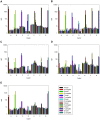Llama single domain antibodies specific for the 7 botulinum neurotoxin serotypes as heptaplex immunoreagents
- PMID: 20098614
- PMCID: PMC2809108
- DOI: 10.1371/journal.pone.0008818
Llama single domain antibodies specific for the 7 botulinum neurotoxin serotypes as heptaplex immunoreagents
Abstract
Background: There are currently 7 known serotypes of botulinum neurotoxin (BoNT) classified upon non-cross reactivity of neutralizing immunoglobulins. Non-neutralizing immunoglobulins, however, can exhibit cross-reactivities between 2 or more serotypes, particularly mosaic forms, which can hamper the development of highly specific immunoassays, especially if based on polyclonal antisera. Here we employ facile recombinant antibody technology to subtractively select ligands to each of the 7 BoNT serotypes, resulting in populations with very high specificity for their intended serotype.
Methods and findings: A single llama was immunized with a cocktail of 7 BoNT toxoids to generate a phage display library of single domain antibodies (sdAb, VHH or nanobodies) which were selected on live toxins. Resulting sdAb were capable of detecting both toxin and toxin complex with the best combinations able to detect 100s-10s of pg per 50 microL sample in a liquid bead array. The most sensitive sdAb were combined in a heptaplex assay to identify each of the BoNT serotypes in buffer and milk and to a lesser extent in carrot juice, orange juice and cola. Several anti-A(1) sdAb recognized A2 complex, showing that subtype cross-reactivity within a serotype was evident. Many of our sdAb could act as both captor and tracer for several toxin and toxin complexes suggesting sdAb can be used as architectural probes to indicate BoNT oligomerisation. Six of 14 anti-A clones exhibited inhibition of SNAP-25 cleavage in the neuro-2A assay indicating some sdAb had toxin neutralizing capabilities. Many sdAb were also shown to be refoldable after exposure to high temperatures in contrast to polyclonal antisera, as monitored by circular dichroism.
Conclusions: Our panel of molecularly flexible antibodies should not only serve as a good starting point for ruggedizing assays and inhibitors, but enable the intricate architectures of BoNT toxins and complexes to be probed more extensively.
Conflict of interest statement
Figures





Similar articles
-
Llama-derived single-domain antibodies for the detection of botulinum A neurotoxin.Anal Bioanal Chem. 2010 Sep;398(1):339-48. doi: 10.1007/s00216-010-3905-3. Epub 2010 Jun 28. Anal Bioanal Chem. 2010. PMID: 20582697 Free PMC article.
-
Evaluation of anti-botulinum neurotoxin single domain antibodies with additional optimization for improved production and stability.Toxicon. 2017 Sep 1;135:51-58. doi: 10.1016/j.toxicon.2017.06.002. Epub 2017 Jun 3. Toxicon. 2017. PMID: 28587791
-
Thermostable llama single domain antibodies for detection of botulinum A neurotoxin complex.Anal Chem. 2008 Nov 15;80(22):8583-91. doi: 10.1021/ac8014774. Epub 2008 Oct 24. Anal Chem. 2008. PMID: 18947189 Free PMC article.
-
The European AntibotABE Framework Program and Its Update: Development of Innovative Botulinum Antibodies.Toxins (Basel). 2017 Oct 2;9(10):309. doi: 10.3390/toxins9100309. Toxins (Basel). 2017. PMID: 28974033 Free PMC article. Review.
-
Mode of action of botulinum neurotoxins: current vaccination strategies and molecular immune recognition.Crit Rev Immunol. 2010;30(2):167-87. doi: 10.1615/critrevimmunol.v30.i2.50. Crit Rev Immunol. 2010. PMID: 20370628 Review.
Cited by
-
Ebolavirus nucleoprotein C-termini potently attract single domain antibodies enabling monoclonal affinity reagent sandwich assay (MARSA) formulation.PLoS One. 2013;8(4):e61232. doi: 10.1371/journal.pone.0061232. Epub 2013 Apr 5. PLoS One. 2013. PMID: 23577211 Free PMC article.
-
Development of neutralizing scFv-Fc against botulinum neurotoxin A light chain from a macaque immune library.MAbs. 2014 Mar-Apr;6(2):446-59. doi: 10.4161/mabs.27773. Epub 2014 Jan 9. MAbs. 2014. PMID: 24492304 Free PMC article.
-
Progress in cell based assays for botulinum neurotoxin detection.Curr Top Microbiol Immunol. 2013;364:257-85. doi: 10.1007/978-3-642-33570-9_12. Curr Top Microbiol Immunol. 2013. PMID: 23239357 Free PMC article. Review.
-
Single-Domain Antibody Multimers for Detection of Botulinum Neurotoxin Serotypes C, D, and Their Mosaics in Endopep-MS.Toxins (Basel). 2023 Sep 17;15(9):573. doi: 10.3390/toxins15090573. Toxins (Basel). 2023. PMID: 37755999 Free PMC article.
-
Biotechnological applications of recombinant single-domain antibody fragments.Microb Cell Fact. 2011 Jun 9;10:44. doi: 10.1186/1475-2859-10-44. Microb Cell Fact. 2011. PMID: 21658216 Free PMC article. Review.
References
-
- Lamanna C. The most poisonous poison. Science. 1959;130:763–772. - PubMed
-
- Herrero BA, Ecklung AE, Streett CS, Ford DF, King JK. Experimental botulism in monkeys–a clinical pathological study. Exp Mol Pathol. 1967;6:84–95. - PubMed
-
- Franz DR, Pitt LM, Clayton MA, Hanes MA, Rose KJ. In: Botulinum and Tetanus Neurotoxins: Neurotransmission and Biomedical Aspects. DasGupta BR, editor. New York: Plenum Press; 1993. pp. 473–476.
-
- Scott AB, Suzuki D. Systemic toxicity of botulinum toxin by intramuscular injection in the monkey. Mov Disord. 1988;3:333–335. - PubMed
-
- Singh BR. Intimate details of the most poisonous poison. Nat Struct Biol. 2000;7:617–619. - PubMed
Publication types
MeSH terms
Substances
Grants and funding
LinkOut - more resources
Full Text Sources
Other Literature Sources

